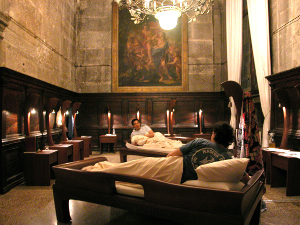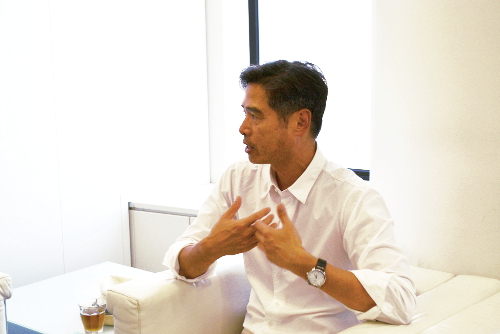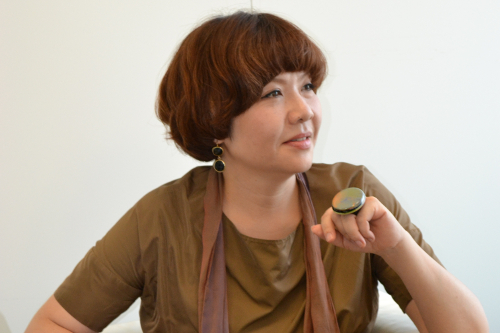Since its opening on Saturday, September 20, "Lee Mingwei and His Relations" affords visitors the opportunity to experience output from the 20-year path of Lee Mingwei's artistic practice. This marks the final round of discussion between Lee and curator of the exhibition Kataoka Mami.

The Sleeping Project
2000
Installation view: The 50th Venice Biennale, 2003
Photo: Gary Lee
Kataoka Mami (hereafter Kataoka): Lee Mingwei projects are characterized by the various relations they create - not only between art and viewer, but also, through art, between one viewer and another. Among them, The Dining Project and The Sleeping Project create especially intimate relations. Through lottery, we pick the participants for these projects, who then come to the museum after hours to share a meal or a night with the artist or member of the museum staff. Like Sonic Blossom, these projects are for one person alone. What inspired to create this sort of "art"?

Lee Mingwei
Lee Mingwei (hereafter Lee): I love the Metropolitan Museum of Art in New York, and I especially love to go into the rooms that no one is in, because when there are no sound distractions from other people, suddenly you feel that a painting or object is engaging in some kind of very direct internal conversation with you. Today the museum gets masses of visitors, but when it was first created in the 19th century, part of it was about sharing the idea of beauty in a very private space and time. I wanted to bring that kind of intimate aesthetic back to the museum.
Kataoka: Let's go back to The Dining Project and The Sleeping Project, because among your works these are truly special.

Kataoka Mami
Lee: They are. Superficially they seem very simple, but they are extremely challenging, and also radical. And with each participant they become different projects. Because everyone is different, each night unfolds differently. So the only way I can prepare for the experience is to be as open as I can. In the past, whenever I thought I was all prepared, it always turned out to be completely different. (Laughs)
And by participating, you walk away owning a dining or sleeping project. So here people own my work, not through monetary means, but through experience.
Kataoka: For The Dining Project, Mingwei or a member of the museum staff goes to the market, gets the fresh ingredients, and prepares a meal just for you. What's interesting in these projects is how you make eating and sleeping - something that everybody does, everyday - art.
The Dining Project
1997
Installation view: Museum of Contemporary Art Taipei, Taiwan, 2007
Collection: JUT Museum Pre-Opening Office, Taipei
Photo: Lee Studio
Lee: We all have our own ritual, the kind of ritual that we didn't have to go to school to learn, but somehow learn from family and friends, and it is ritual that is extremely intimate to us. In The Sleeping Project, for example, we may talk, talk, talk, and suddenly it gets to a point of should I take off my socks now? Should I get up and change into pajamas? When should I turn off the light? Should I say goodnight to you? Or should I wait for you to say goodnight to me first? There are hundreds and thousands of very moments involved in this work.
Kataoka Mami (left) and Lee Mingwei (right)
Kataoka: There are many, many aspects of your work that don't conform to conventional notions of what constitutes art. What art is for you?
Lee: Art is something that when I experience it, the experience changes me somehow inside - small or big. And sometimes that transformation doesn't happen at the moment of experience. It happens maybe three or ten years later. And that brings me back to that moment of encounter with this object or event that I call art.
Kataoka: You say that your shows are only 40 percent ready when the show opens, which means that more than half is completed by the visitor and participants in your projects.
Lee: That's right. The 60 percent comes from the richness of the participation. I think with most of my work, the participation is so important because it changes the artwork. And more importantly, that change in the artwork then changes the viewer, and changes me.
Original Text (in Japanese-language): Aono Naoko (Editor/writer)
Translation: Miki Pamela
Issue 68 of HILLS LIFE, the latest issue of the area magazine packed with info from street news to trends all to make life at the Hills more fun, features a related conversation between Lee Mingwei and Kataoka Mami. Don't miss it!
Read the PDF edition (in Japanese) here
■Related links
・Dialogue between Lee Mingwei and Kataoka Mami
(1) What is "Participatory Art"?
(2) When "Gift-giving" Becomes Art
(3) Art Enriched by How We Participate
・"Lee Mingwei and His Relations: The Art of Participation: Seeing, Conversing, Gift-giving, Writing, Dining and Getting Connected to the World"
Saturday, September 20, 2014 - Sunday, January 4, 2015
・"MAM Project 022: Jacob Kirkegaard"
Saturday, September 20, 2014 - Sunday, January 4, 2015








